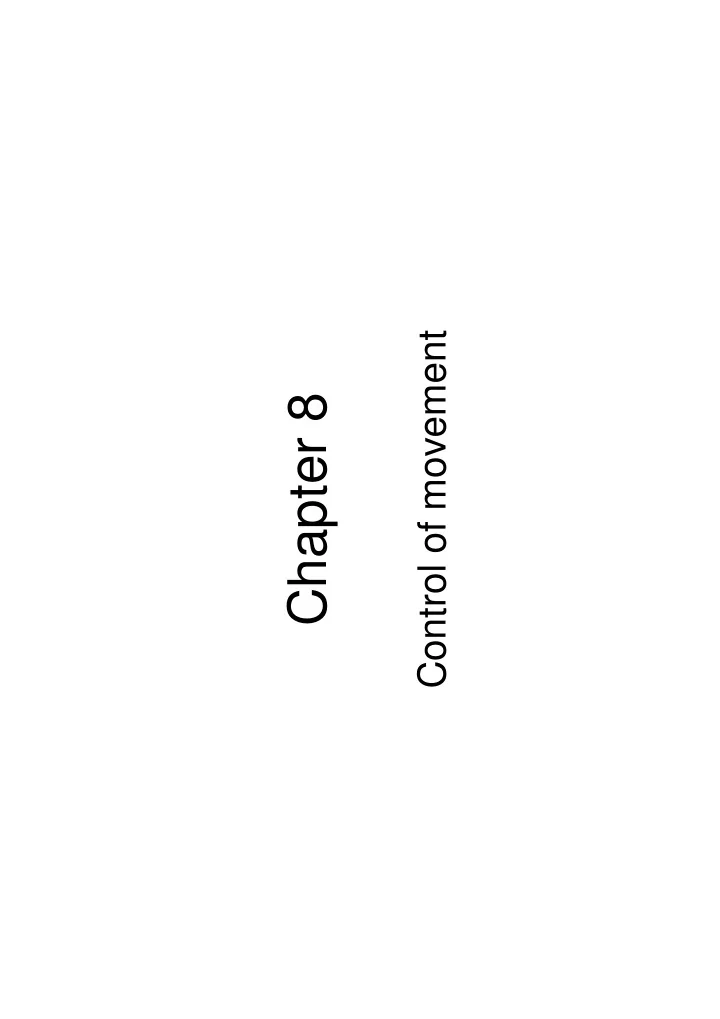

Control of movement Chapter 8
1st Type: Skeletal Muscle • Skeletal Muscle: Ones that moves us – Muscles contract, limb flex • Flexion: a movement of a limb that tends to bend its joints, contraction of a flexor muscle (bending) • Extension: movement of a limb that tends to straighten its joints, contraction of an extensor muscle (straightening) – Two fiber types of skeletal muscle • Extrafusal: exert force (alpha motor neurons) • Intrafusal: detect stretch of muscle (1 sensory & gamma motor axon) – Afferent sensory axon detects muscle length – Efferent gamma motor axon contracts intrafusal, adjust sensitivity – Myosin and actin – Golgi tendon organ: strength/stress detector
Neuromuscular junction: endplate potential • The neuromuscular junction is point where the terminal buttons synapse with the motor endplates – Precision of muscle control • Ach is the muscular neurotransmitter (animation) – Release of Ach produces a large endplate potential • Larger than EPSPs and always causes a muscle to fire – Open Ca2+ channels that trigger myosin-actin interaction (row action) – Contraction or muscular twitch • Twitch lasts because of elasticity of muscle & time it takes calcium to leave the cell
Other two types of muscles • Smooth muscle: controlled by ANS – Multiunit: inactive, large arteries, around hair and in the eye, responds to neural or hormonal stimulation – Single-unit: rhythmic, spontaneous pacemaker potentials, gastrointestinal tract, uterus • Cardiac muscle: found in heart – Striated with rhythmic contractions, respond to hormone especially the catecholamines
Monosynaptic stretch reflex • Patellar reflex • Involve single synapse • Afferent sensory neuron in intrafusal fibers sends information to spinal cord • Efferent alpha motor neurons in spinal cord innervates extrafusal fibers to contract • Also found in weight holding and posture control
The Postsynaptic Reflexes • Situation: withdraw from harmful muscle movement – Afferent: sensory neuron + golgi tendon organ – Interneuron— inhibition – Efferent: alpha neuron • Weight lifter • Agonist and antagonist
Cortical Controls of Movement • Multiple motor systems control body movements – Walking, talking, postural, arm and finger movements • Primary motor cortex is located on the precentral gyrus – Motor cortex is somatotopically organized (motor homunculus) – Motor cortex communicates with • Primary somatosensory cortex (same body part) • Supplemental motor area • Premotor cortex • Prefrontal cortex • Supplemental motor area (SMA) – Leaning and performing behaviors that consist of sequences of movements • Premotor cortex – Arbitrary stimuli – Imitating and understanding other individual’s movement---Mirror neurons
Somatotopic organization of primary motor cortex
Lateral Group • Originates from cortex, most of them end in spinal cord • Lateral corticospinal tract (light blue)—finger,hands, arm • Rubrospinal tract (red)—hands (no fingers), lower arms, feet and lower legs • Corticobulbar tract(green): face and tongue, ends in cranial nerve • [ventral corticospinal tract (dark blue): hands (no finger), lower arms, feet and lower legs]
Ventromedial group • Originates in subcortical region and ends in spinal cord • Tectospinal tract (blue)— neck and trunk • Lateral reticulospinal tract (purple)—flexor muscles of legs • Medial reticulospinal tract (orange)—extensor muscles of lges • Vestibulospinal tract (green)—trunk and legs
The apraxias • Paralysis or weakness: damage to motor structure (perceptual gyrus, basal ganglia, brainstem or spinal cord) • Apraxia: an inability to properly execute a learned skilled movement following brain damage, in absence of paralysis or muscular weakness: damage to corpus callosum, frontal lobe or parietal lobe • Limb apraxia: incorrect movements of arms, hands or fingers
Limb Apraxia • Callosal apraxia – Damage: Anterior corpus callosum – Apraxia of the left limb • Sympathetic apraxia – Damage: Left frontal lobe – Paralysis of right; Apraxia of the left limb • Left parietal apraxia – Damage: Left intraparietal sulsus – Apraxia in both limbs
Construction Apraxia • Damage: right parietal lobe • Deficits in ability to perceive and imagine geometrical relations • Trouble drawing pictures or assembling objects from elements
The Basal Ganglia • Basal ganglia consist of the caudate nucleus, the putamen and globus pallidus – Input to the basal ganglia is from primary motor & somatosensory cortex and the substantia nigra – Excitatory neurons: glutamate; inhibitory neurons: GABA – Direct pathway: excitatory effect on movement • Caudate nucleus and putamen, GPi, thalamus – Indirect pathway: inhibitory effect on movement • Caudate nucleus and putamen, GPe, subthalamic nucleus, GPi, thalamus – Output is to motor areas & brainstem motor nuclei • Influence movement and some direct control, slower than the movements controlled by cerebellum • If dopamine pathway from substantia nigra to basal ganglia is degenerated---Parkinson’s disease
Parkinson’s Disease • Parkinson’s disease (PD) involves muscle rigidity, resting tremor, slow movements & postural instability – Parkinson’s results from damage to dopamine neurons within the nigrostriatal bundle – Caused by toxins, faulty metabolism, infectious disorder or rare juvenile genetic component • Treatment for PD – Dopaminergic agonists (increase NT) like L-DOPA – Stem cell research: transplants of dopamine-secreting neurons (fetal substantia nigra cells) – Lesions of the globus pallidus alleviates some symptoms of Parkinson’s disease
Huntington’s Disease • Huntington’s disease (HD) involves uncontrollable, jerky movements of the limbs – HD is caused by degeneration of the caudate nucleus and putamen – Degeneration of GABA & Ach neurons • HD is hereditary disorder (30-40 yrs ago) caused by a dominant gene on chromosome 4 – This gene produces a faulty version of the protein huntington – May interfere with glucose metabolism
The Cerebellum • Cerebellum consists of two hemispheres with associated deep nuclei – 50 billion neurons with output to every major motor structure – The butt (caudal) involved in postural reflexes (communicates with vestibular system): flocculonodular lobe – The middle (midline) receives visual & auditory info and cutaneous & kinesthetic info: The Vermis • Damage to the cerebellum generally results in jerky, erratic and uncoordinated movements
Reticular formation • Gama motor system • Pons and medulla, respiration, sneezing, coughing and vomiting • Postural control • locomotion
Recommend
More recommend